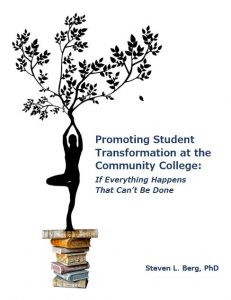Promoting Student Transformation at the Community College
 I am very proud that HASTAC has published, as an Open Educational Resource (OER), my book Promoting Student Transformation at the Community College: If Everything Happens That Can’t Be Done. HASTAC describes it as: “A narrative guide to teaching, featuring practical pedagogical advice for engaging students and addressing a variety of student needs.”
I am very proud that HASTAC has published, as an Open Educational Resource (OER), my book Promoting Student Transformation at the Community College: If Everything Happens That Can’t Be Done. HASTAC describes it as: “A narrative guide to teaching, featuring practical pedagogical advice for engaging students and addressing a variety of student needs.”
Each chapter in the book consists of five essays around a theme before ending with a list of practical tips and tricks that we can implement in our lives as professors.
While the book is a celebration of transformation, I begin and with an acknowledgement that we are teaching and learning and transforming in difficult times. As a result, the theme of the first chapter is “Overcoming Pervasive Dissatisfaction.” If we cannot overcome the many things about which to be dissatisfied in contemporary America and contemporary American education, we can lose the sympathetic joy embedded in our profession.
Although the book begins with a recognition of pervasive dissatisfaction, Promoting Student Transformation at the Community College is a book that focuses on how we can persist in our individual classrooms as we work to transform students’ lives as well as our own. Although theory is discussed, this is not a book of theory. It is a book that provides specific examples that community college professors—and our university colleagues—can move “transformative experience” from a clichéd buzzword to a practical reality.
The essays in the book are both short and accessible. They, and the art that accompanies them, are designed to provoke thinking, reflection, and discussion for faculty members and our students. Last week, I taught “Accepting the Reality of Our Ignorance” to an introductory writing class. This essay, which is in the chapter on “Finding Joy in Student Success” sparked a lively discussion as to the role of students in the classroom while encouraging students to realize their own expertise. The realizations I address in that essay keep me humble which makes me a more empathetic instructor.
When students ask, “How long did it take you to write the book?” I generally reply, “a couple of years.” But a most accurate answer is “I began writing this book more than 50 years ago.”
The seeds of the book can be found even before I taught my first Catechism class at St. John’s Parish in Essexville, Michigan. My thoughts on pedagogy germinated though high school and took root as an undergraduate at Michigan State University’s Justin Morrill Liberal Arts College. And the ideas grew and were developed while teaching as a graduate student at Michigan State and later as an adjunct faculty member at another university and three community colleges; one of which hired me as a full time faculty member 20 years ago.
In “Swimming in the Deep End,” I argue that we don’t just jump into the deep end. As a child, I almost drowned by doing so. Instead, we take steps from semester to semester to improve on our strengths to better collaborate with students on their—and our own—transformation.
I would like to make a few acknowledgements here: Promoting Student Transformation at the Community College received support from the CUNY Humanities Alliance, and the Andrew W. Mellon Foundation. The quality of the book was greatly enhanced by the skillful editing of Dr. Jay Polish, a scholar and science fiction writer, and a former CUNY Humanities Alliance Fellow at the Graduate Center, CUNY.
–Steven L. Berg, PhD

This work is licensed under a Creative Commons Attribution-NonCommercial-ShareAlike 4.0 International License.
LEAVE A COMMENT